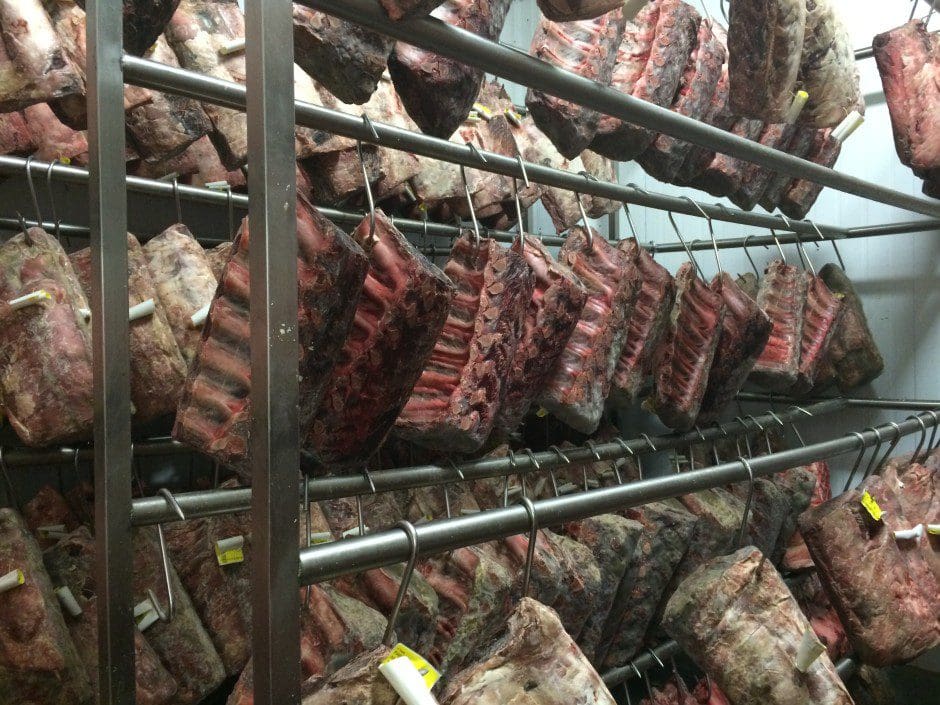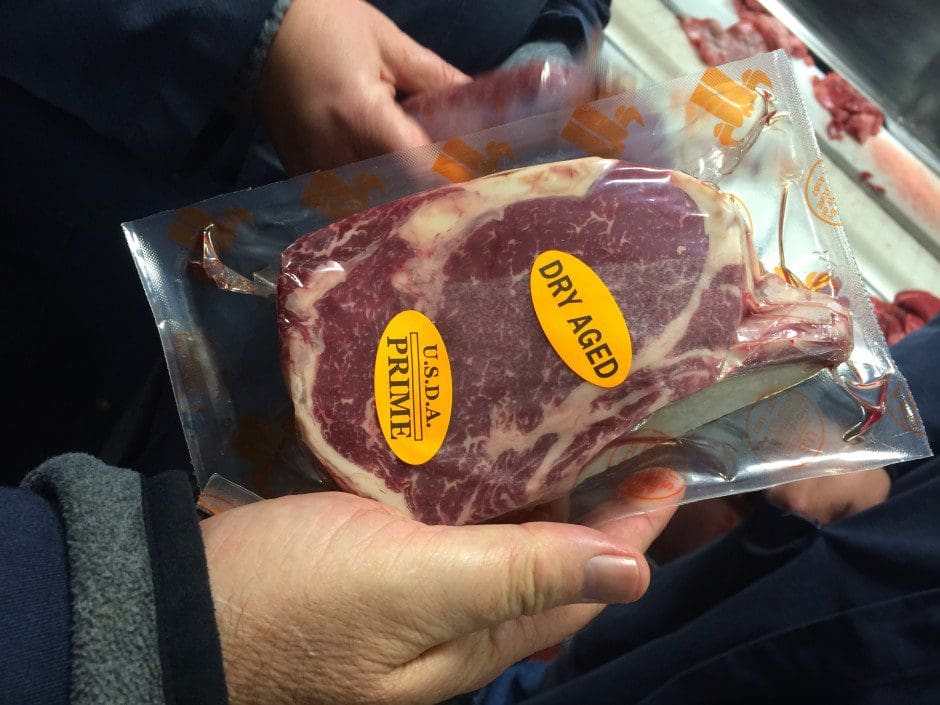LOS ANGELES, March 21st, 2015 ― Steak: Rib Eye, Porterhouse, NY Strip ― all are favorites. How do you make them perfect?
The rich, decadent and mouthwatering flavor of a perfectly aged piece of meat is a always a great way to show someone you love them, so here are some helpful hints on how to buy, prepare and cook the perfect Rib Eye, Porterhouse, NY Strip and burger.
What type of steak should I buy?
Start by searching for the freshest meat. Look for a bright red color (unless Cryovacked then it might be purple). The meat should be soft but firm to the touch. The blood (actually myoglobin, if you’re picky about these things) that comes from it should be red, not brown. The blood and meat should smell clean and a bit sweet.
A good test for steaks is shared by one of Italy’s finest Chefs, Valter Roman of the Tuscan Chef Cooking School. Put your thumbnail into the beef; when you remove your nail, its imprint would remain in the meat for a few seconds, then fade away.
You really want to spend the extra money to buy quality meats, particularly if dad likes his steak very rare. Find a butcher who sells fresh meats, or visit a quality supermarket like Whole Foods, where the butchers can help you find the best cut and provide grilling tips.
If you really want to splurge, many Whole Foods now offer dry-aged meats, but you should reserve as far in advance as possible.
Different cuts have different textures and call for different cooking styles. A prime rib, for example, has a lot more fat, which produces softly textured, sweetmeat, that pairs well with horseradish sauces. A prime rib or porterhouse does well with a minimum of pre-preparation. Tried and true is to let the meat sit on the counter until it reaches room temperature, covering it with a light rub of a little quality olive oil, salt, white pepper and crushed garlic.
Those flavors will soak in while the meat is warming. Never put ice-cold steak on the grill. It will cook quickly on the outside, but remain raw on the inside.
Most American connoisseurs prefer their steak medium-rare; if you’re French, you’ll probably prefer it rare. You never want to overcook steak; it becomes tougher and drier as you cook it longer.
Medium rare steaks have a bright pink center, not the translucent bleeding red color of raw beef. The juices should be red, but they should be clear and light, not dark. (The juices should never actually look like blood, even when the meat is raw.)
Cooking prime rib or porterhouse steaks requires a hot fire that will quickly sear the outside of the meat. If you cook it too slowly, the fat will melt and the meat can fall apart. These steaks should always be served medium rare at the hottest.
If your family likes a medium to well done steak, consider sirloin.
Sirloin, a less expensive cut with little fat, requires a moderate, even temperature to cook more slowly. It is a denser meat that slices well for platter serving. This more moderately priced steak will benefit from an overnight marinade and a slow grill.
Sirloin can also be slowly precooked in the oven, like a roast, on a very low heat so that it stays very rare in the center.
Just remember that the lack of fat in the meat means it can and will dry out. It needs to be well marinade and cooked with extra fat, kept covered or wrapped in foil while precooking.
Should I buy a thermometer?
An instant-read thermometer could help you determine the temperature of the meat if you are a novice cook or if you are cooking a large piece of meat. Otherwise use the clenched fist test. Make a loose fist with one of your hands and use your finger on the opposite hand to touch your fist in three places: your thumb (in-between the knuckle and joint) for well done, your pointer finger (in-between the knuckle and hand joint) for medium-rare and the fatty place on your hand that resides between your thumb and pointer for rare. If all else fails look to see if your steak has red juices pooling on the top, that is an indication your meat is medium-rare.
Cooking
What temperature should a steak be? A quality piece of meat should not be served over 145°F. Well-done is over 165°F; rare is 125°F. I do not suggest serving a T-bone or strip steak rare, because it does not allow the fat in the steak to melt, and the fat is where the flavors reside. However, if you like a rare steak try it with a filet because the flavor resides in the meat itself and not in the fat.
The time to start checking is when you can really smell the flavors of the steak, not just smell the initial burn you get when you toss it on the grill.
Ask your butcher, or search online, for suggestions of cooking times based on the thickness and cut. A rule of thumb is, for a medium-sized cut, say one inch to one-and-a-half inches in thickness, to cook it is five minutes over direct heat (rotating it at 3 minutes) on a hot grill on one side, then flip for three to four minutes. Press the center with your thumb, if mushy, cook for another minute on both sides.
If the flesh is firm and springs back, it should be medium rare.
Check, but as few times as possible; every time you puncture your steak, it loses juices. At 130-135°F, take it off the direct heat, putting it on a plate on an upper shelf of the grill or covering to the side, and let it sit (rest) for 5-10 minutes. The temperature will rise another 10°F as it rests.
Garnish the plate and serve.
Ground beef for burgers
Fresh ground beef is relatively easy to buy, but what makes it tricky is not the freshness, but the fat-to-meat ratio. As in your steaks, it’s all about the fat.
For more flavorful burgers, try 80 (meat)/20 (fat) ground beef; for a healthier version try either an 85 (meat)/15 (fat) or 90 (meat)/10 (fat). At Whole Foods, you can purchase a pound of the grass feed, very lean meat, and mix it with a half-pound of an 80/20 mix to introduce some fat. This gives you that grass-fed, quality beef flavor and the fat that makes a good burger juicy.
The trick is to buy enough meat for your hamburger buns. An 80/20 patty will shrink by almost half when it’s cooked, while an 85/15 patty will only shrink by about one-third; a 90/10 patty will stay almost the same size.
There is nothing worse than a small hamburger patty hidden inside an enormous hamburger bun. A good rule of thumb is to make three patties per pound of meat.
You need to make your patty, once flattened larger then the bun all the way around so once shrunk, it fits.
Marinades, rubs and basting
Marinades, rubs and basting can add a lot of flavor to your meats. Marinades are used on tough pieces of meat like tri-tip, skirt steak or flank steak. The proteins in these cuts need the acid in a marinade to help break down the muscle fibers.
Marinades work best if they’re left on for at least two to three hours. If you have cut of beef that’s really tough and large, leave it soaking in the marinade for up to two days. The flavor of the marinade will penetrate deep into the meat.
Rubs are a mixture of seasonings rubbed deep into the fibers of the meat. Rubs are best used before grilling with any type of protein (steaks, hamburgers, chicken). The key to rubs is to use a little bit of oil and rub the seasonings into the meat. It will create a nice, crusty layer.
Basting uses s a liquid-like barbecue sauce, honey mustard or an orange soy sauce reduction. Bastes are painted onto browned meat.
Basting is best done toward the end of cooking; the mixtures can have a lot of sugar in them, and if you baste meats too early, the sugars can flare the fire and end up burning your perfectly cooked meats.
When you baste at the end, the baste reduces and caramelizes onto the meat, leaving a delicious outer layer of flavor.
When you grill you can use all three of these techniques. The flavors of the marinade, baste and rub should be similar or complementary to prevent them from fighting over your taste buds.
One trick to cooking meat and enjoying your event is to undercook your meat ahead of time, then before serving finish it off on a low grill.
If you cook to serve, check your meat with an instant-read thermometer and remove it from the fire when the temperature reaches 10 degrees below ideal; the meat, particularly thicker cuts, will continue to cook after it is removed from the grill. A steak should be allowed to sit for five minutes or so before slicing to allow the hot juices to settle into the meat instead of running out all over the plate.
If you slice the steak before serving, sprinkle a coarse sea salt it will help to settle any liquids.
Follow these tips and you will be able to enjoy your party without stressing over raw meat, dry meat, and a ruined meal.
Here are the ingredients of some favorite rubs. Combine to your favorite flavor profile, adding a little more or less spice or other flavors to suit your own tastes:
Rubs:
Paprika Rub
- 1-tablespoon paprika
- ½ tablespoon garlic powder
- Salt and cracked pepper
Rosemary Rub
- ½ tablespoon chopped rosemary
- 1 tablespoon chopped Italian parsley
- ½ tablespoon olive oil
- Salt and cracked pepper
Creole Rub
- 1 tablespoon Creole Seasonings
- ½ tablespoon oil
- Salt and cracked pepper

